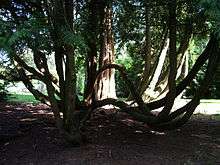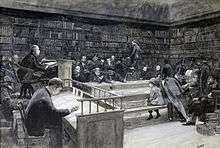West Dean House
West Dean House is a large flint-faced manor house situated in West Dean, West Sussex, near the historic City of Chichester. This country estate has approximately 6,350 acres (25.7 km2) of land and dates back to 1086, with various royal connections throughout the years. In 1971 the Estate became the home of West Dean College, a centre of study of conservation, arts, crafts, writing, gardening and music.
West Dean is Grade II* listed on the National Heritage List for England, and its landscaped park and gardens are equally listed Grade II* on the Register of Historic Parks and Gardens.[1][2]
The Medieval estate
The earliest known reference to the West Dean Estate is found in the Domesday Book in 1086, where it was included in the manor of Singleton as, a forest and hunting park. The Earls of Arundel and the Dukes of Norfolk held these lands for almost 500 years until 1572, when the 4th Duke of Norfolk was accused of treason. He was stripped of his possessions by Elizabeth I and then beheaded . She later restored the properties and title to the Duke's eldest son Phillip. It was Phillip who built the first manor house at West Dean, West Sussex in 1603, then known as Earl’s Court, later to be renamed Canon House due to its connections to Chichester Cathedral.[3]
The Jacobean manor
In 1621 Phillip sold the manor and it passed into various ownerships, including the Sussex families of John Aylwin of Lewes and Richard Lewkenor of Stoughton. It was John Lewkenor in 1622 who built the Jacobean Manor house, on the site that was previously occupied by the medieval building. The building was built in an E-shape, common in the late 16th century.
The Peachey family

In 1738 the West Dean Estate passed into the hands of the Peachey family from Petworth, just over the South Downs. Sir James Peachey, the 1st Lord Selsey, commissioned the leading architect of time, James Wyatt to rebuild the manor house, creating the core flint mansion seen at West Dean today. Wyatt is also responsible for the orangery on the West Dean estate. James went on to gain a vast acreage of land, leaving it to his son, Sir John the second Lord Selsey on his death. John was responsible for laying out the parkland and arboretum in West Dean. All of John’s children were without heirs, and in 1871 the last Peachey died. Recently there has been a link made with the Peachey family of Portsmouth.
The James family

In 1891 West Dean became the home of newly married William (Willie) Dodge James and Evelyn Forbes the daughter of Sir Charles Forbes, a Scottish aristocrat.[4] William James had inherited great wealth from his father, American born Liverpool based merchant Daniel James. He bought West Dean from Frederick Bowers, a merchant who had owned the property since the death of its previous owner, Caroline Mary (Peachey) Vernon Harcourt (1785-1871). She had inherited the estate when her brother, Henry John Peachey, 3rd Baron Selsey died in 1838. Caroline was the wife of Rev. Leveson Venables Vernon Harcourt, son of Edward Venables-Vernon-Harcourt, Archbishop of York.[5] In her will she had bequeathed West Dean to a distant relative, Ulick de Burgh, 1st Marquess of Clanricarde, who immediately sold it to Frederick Bowers.[6] Clanricarde also disposed of several other properties left to him by Caroline plus the extensive library housed at West Dean, the sale of which took nine days at Sotheby's and included a copy of John Gower's rare Confessio Amantis that sold for £670.[7]
When James moved to the West Dean Estate in 1891, he set about altering and greatly extending the house and commissioned Ernest George and Harold Peto to do so. Ernest George helped embellish the state rooms and Harold Peto designed a 300-foot (91 m)-long pergola, still a highlight of the gardens today. West Dean House became one of the largest flint structures in the country. The interior of the house reflects William and his brothers Frank and Arthur’s, passion for big game hunting, with souvenirs of their visits to Africa, Arabia and Afghanistan displayed throughout the house.
House parties at West Dean were attended by The Prince of Wales - who became King Edward VII when his mother Queen Victoria died. He was Edward James’s Godfather and a regular participant of pheasant and partridge shoots on the West Dean estate. The Prince of Wales had a group of rich and entertaining friends that became known as the Marlborough House set and included people like Evelyn and her sister-in-law Mary Venetia James (née Cavendish-Bentinck).[8]
William and Evelyn had five children, four girls, Millicent, Alexandra, Silvia and Audrey. In 1907, after 18 years of marriage, their son and heir Edward James was born.
William became High Sheriff of Sussex in 1897 [9] and Deputy Lieutenant of Sussex in 1892.[10] He was also appointed Commander of the Royal Victorian Order by Edward VII in 1908.[11]
Edward James
Edward James was born on 16 August 1907, the only son of William Dodge James who had inherited a fortune from his father on his 25th birthday in 1879 (Daniel James's will, CODICIL 13th day of April 1876) and who became an adventurer, accompanying his brother Frank Linsly James on many of his expeditions, often drawing maps of uncharted lands.[12][13][14][15] His mother was Evelyn Forbes, a Scots socialite, who was reputedly fathered by the Prince of Wales (later Edward VII).[16] Edward James had four older sisters: Audrey, Millicent, Xandra, and Silvia. He was educated briefly at Eton, and then at Le Rosey in Switzerland, followed by Christ Church, Oxford, where he was a contemporary of Evelyn Waugh and Harold Acton. In 1912 he inherited the 8,000-acre (32 km2) West Dean House in Sussex, on the death of his father. He was only aged four at the death of his father in March of that year; however Edward did not take control of the estate until he was 25.
In 1939 Edward James wrote to Aldous Huxley expressing his fear that after the war, certain arts, and particularly the techniques of the craftsmen would be lost. As a solution James suggested that his estate be set up as an educational community where the techniques of craftsmanship could be preserved and taught, whilst restoring old work and creating new art works. In 1956 Wispers School, an independent boarding school for girls aged between 11 and 18, moved to West Dean House.[17][18] In 1964 James gave the House to a charitable trust, The Edward James Foundation, but the school was able to remain at West Dean until 1968.
West Dean College

The Edward James Foundation was established in 1964 as a charitable, educational trust which supports and teaches artists and craftsmen and in 1971 the Foundation established West Dean College which offers full-time and short courses.
Since the House became a college, extensive alterations and additions have been made to the bedrooms and former service areas of the house, in order to make it suitable for students. Roofing over the former stable yard and the surrounding buildings has enabled arts and crafts workshops to be built. All the work took place over a period of 20 years, directed by architect John Warren, who tried to retain the historical features of the house.
Major repair and improvement work was due to be carried out on the roof in 2019. A planning application was made to the South Downs National Park in 2017.[19][20]
The West Dean estate
The West Dean Estate has approximately 6,350 acres (25.7 km2) of land. The estate has 136 houses and cottages, as well as more than 100 farm buildings; some are occupied by the staff of the estate and college, as well as by pensioners of the foundation and local families. There are twelve farms on the estate, many of which have been owned by the estate for generations; their agricultural activates are split between livestock and cereals.
Woodlands make up around 2,000 acres (8.1 km2) of the estate, the main tree species being the native beech, found on the South Downs. The woodlands were badly affected by the storms of 1987 and 1990, and the woodland took over a decade to recover. The woodlands have become increasingly important, particularly when they began to supply the key fuel to provide heating for the estate in the 1970s. After the old boilers and electric heaters proved to be incapable with dealing with the needs of the ever growing West Dean College, other methods were looked into, and wood fuel appeared to be the most eco-friendly alternative. One thousand two hundred tonnes of wood chippinga are needed to supply not only West Dean College, but several other buildings on the estate as well, including the village church. The woodland also conceals a rich heritage with sites like Goosehill Camp dating back to the Iron Age.
See also
References
- Historic England, "West Dean College West Dean Park (1026116)", National Heritage List for England, retrieved 26 October 2017
- Historic England, "West Dean (1000190)", National Heritage List for England, retrieved 26 October 2017
- Salzman, Edited by L F. "A History of the County of Sussex: Volume 4, the Rape of Chichester". British History Online. Originally published by Victoria County History, London, 1953. Retrieved 21 September 2016.CS1 maint: extra text: authors list (link)
- "Mrs William (Willie) Dodge James". Russell Harris. 2011. Retrieved 21 March 2013.
- "Caroline Mary Vernon Harcourt (née Peachey)". National Portrait Gallery. Retrieved 20 September 2016.
- "Wills & Bequests". Morning Post. 8 September 1871.
- "Chichester - The Rare Book". Hampshire Telegraph. 20 July 1872.
- Knights-Whittome, David. "The Marlborough House Set". National Portrait Gallery. Retrieved 20 March 2013.
- "Gazette Issue 26828 published on the 2 March 1897. Page 2 of 94". High Sheriff of Sussex. London Gazette. Retrieved 20 March 2013.
- "Gazette Issue 26324 published on the 9 September 1892. Page 7 of 56". Deputy Lieutenant of Sussex. London Gazette. Retrieved 20 March 2013.
- "Gazette Issue 28193 published on the 6 November 1908. Page 1 of 136". London Gazette. Retrieved 21 March 2013.
- Dodge, Phyllis (1987). Tales of the Phelps Dodge Family. w York: New York Historical Society. p. 108.
- "DEATH OF CAPT. W. A. MATTHEWS, OF COWES" (PDF). THE ISLE OF WIGHT COUNTY PRESS - SATURDAY DECEMBER 22, 1928. Retrieved 19 March 2013.
- James, Frank (1888). The Unknown Horn of Africa. Fleet St: George Phillips & Son. p. Title page/Frontispiece.
- James, Frank (1883). The Wild Tribes of the Soudan. New York: Dodd Mead & Company. p. vi.
- Melly, George (1982). Swans Reflecting Elephants. London: Weidenfeld & Nicolson. p. 6.
- "Shock closure of award-winning school". Midhurst and Petworth Observer. 6 May 2008. Retrieved 30 May 2011.
- "Sid Hitchman 29 April 1930 - 23 September 2008" (PDF). The Valley Diary. 2009-01-xx. Retrieved 2011-05-21. Check date values in:
|date=(help) - "Planning – Planning Application Documents". South Downs National Park. The Trustees of The Edward James Foundation. Retrieved 23 December 2018.
- "DRAFT DESIGN & ACCESS STATEMENT WITH LANDSCAPE AND VISUAL IMPACT ASSESSMENT" (PDF). South Downs National Park. Retrieved 23 December 2018.